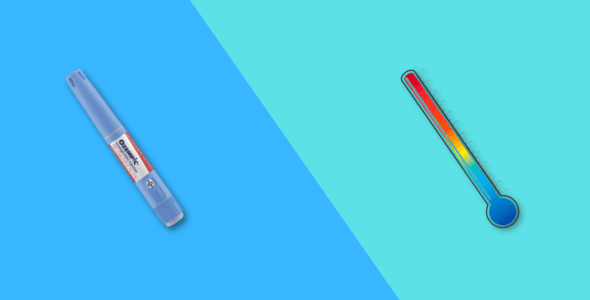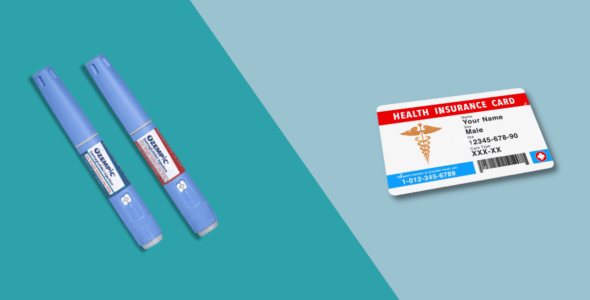Ozempic side effects: What you need to know
Ozempic is making headlines for its effectiveness, but what are its side effects? Get the full, unbiased breakdown before starting or continuing treatment.
Key highlights
- Ozempic (semaglutide) is a GLP-1 receptor agonist subcutaneous injection approved by the FDA for type 2 diabetes management. It is also used off-label for weight loss.
- The most common side effects of Ozempic include GI-related events (nausea, vomiting, diarrhea, constipation, stomach pain, bloating, gas, burping), fatigue, headache, dizziness, and injection site reactions.
- Most gastrointestinal side effects appear when starting the medication and dose escalation. They can be managed with lifestyle and dietary modifications. These side effects settle within a few weeks as your body adjusts to the changes in the digestive system.
- Some patients taking semaglutide injections also report adverse events like pancreatitis, gallbladder problems, kidney problems, hypoglycemia, vision changes, allergic reactions, thyroid tumors, gastroparesis, and mental health issues.
- The rare and long-term side effects of the drug must be reported to the doctor immediately. Individuals experiencing persistent vomiting and abdominal pain must also inform their healthcare provider to prevent complications.
Ozempic is a subcutaneous injectable drug approved by the U.S. Food and Drug Administration (FDA) for type 2 diabetes management and is widely used off-label for weight loss. It is also prescribed to reduce the risk of adverse cardiovascular events (such as heart attack) in patients with type 2 diabetes, high blood pressure, and heart disease. Ozempic has been seen to reduce the risk of end-stage kidney disease, eGFR decline, and cardiovascular death in adults with type 2 diabetes and chronic kidney disease.
The active ingredient in Ozempic is semaglutide. Semaglutide is a glucagon-like peptide-1 (GLP-1) receptor agonist that works by stimulating insulin secretion, reducing glucagon levels, and delaying gastric emptying. Patients report numerous common and rare side effects when starting GLP-1 agonist drugs like Ozempic.
Gastrointestinal side effects, such as nausea, vomiting, constipation, diarrhea, and stomach pain, along with injection site reactions and mild hypersensitivity reactions are most commonly reported. Some rare yet serious side effects of the medication include kidney disease, gallbladder problems, pancreatitis, worsening of diabetic retinopathy, hypoglycemia, pulmonary aspiration, and behavioral changes. Serious side effects, especially severe hypoglycemia and serious allergic reactions require immediate medical attention. However, not all patients experience these side effects and the severity of these adverse events may vary among individuals.
This comprehensive guide tells you everything you need to know about the side effects of Ozempic, including common, serious, and long-term side effects of the drug. We have also shared management tips and crucial information regarding the medication’s use to help you manage and treat the side effects of Ozempic efficiently.
How Ozempic works and why side effects occur
Ozempic is a glucagon-like peptide-1 receptor agonist drug that mimics the GLP-1 hormone to slow down digestion and delay gastric emptying. This makes you feel fuller for longer and reduces appetite to promote weight loss. It helps regulate blood sugar levels by:
-
Increasing insulin release (when needed)
-
Reducing liver sugar production
-
Regulating glucagon levels in the blood
The action of this drug on the digestive system leads to changes in the digestive processes, resulting in gastrointestinal side effects, such as vomiting, nausea, diarrhea, constipation, abdominal pain, and gastroparesis (rare but serious). Injecting the subcutaneous pen in the same spot every time can cause injection site reactions, and patients with hypersensitivity to the active or inactive ingredients in the drug might experience allergic reactions during administration.
Most common Ozempic side effects
Patients taking Ozempic and other GLP-1 receptor agonist drugs might experience side effects when starting the medication or increasing the dose. Most common side effects of Ozempic usually subside after 4-8 weeks as your body adjusts. If the issues persist, your healthcare provider can modify the treatment regimen and change the maintenance dose depending on your tolerability limits.
Gastrointestinal issues (32% of users)
In placebo-controlled clinical trials, 32.7% of patients taking Ozempic 0.5 mg reported gastrointestinal adverse events, followed by 36.4% incidents in the Ozempic 1 mg group, compared to 15.3% in the placebo group. They are usually transient and resolve once the maintenance dose is reached. In most cases, gastrointestinal side effects are mild to moderate in severity and following dietary recommendations will help relieve symptoms.
Nausea (15-20% of users)
Reports show that 15.8% of individuals taking Ozempic 0.5 mg and 20.3% of those taking the 1 mg dose experienced nausea, in comparison to 6.1% of participants in the placebo group. Users start feeling nauseous when initiating the medication and the condition typically settles within a few weeks. Nausea and vomiting are more common in patients taking higher doses of the medication. You can try the following to manage nausea when using Ozempic:
-
Take smaller, bland meals, such as rice, toast, and crackers
-
Opt for boiled and grilled food items instead of fried meals
-
Avoid spicy, greasy, and sweet foods
-
Take nutritious meals with high water content, such as soups, watermelon, etc.
-
Do not lay down immediately after eating
-
Take a walk after your meal
-
Chew on ginger or take bismuth subsalicylate for relief
In case the above-mentioned remedies do not offer satisfactory results, talk to a healthcare professional regarding the use of a suitable antacid.
Diarrhea (8-9% of users)
Diarrhea is another common side effect of Ozempic, reported by 8.5% of individuals using Ozempic 0.5 mg and 8.8% of the Ozempic 1 mg group, whereas 1.9% of participants in the placebo group also experienced it. Prolonged diarrhea can lead to loss of fluid, causing dehydration, which may damage your kidneys if not treated timely.
Patients who experience diarrhea while taking Ozempic must stay hydrated to replenish their body fluids. Avoid greasy and spicy food, caffeine, and alcohol to prevent and control diarrhea. You can also add probiotics to your diet to improve gut health. If it does not get better in a few weeks, discuss it with your doctor so they can provide you with an adequate treatment option.
Vomiting (5-9% of users)
Like nausea, many people also experience vomiting when taking Ozempic. Reports show that 5.0% of individuals taking Ozempic 0.5 mg and 9.2% of users taking Ozempic 1 mg experienced vomiting, compared to only 2.3% of those in the placebo group. Volume depletion due to prolonged vomiting also leads to dehydration and may cause Acute Kidney Disease (AKD) requiring hemodialysis.
Doctors typically start the medication with the lowest dose to minimize gastrointestinal side effects, such as vomiting. When experiencing vomiting, take small amounts of clear liquids every few minutes to stay hydrated. If it does not resolve in a few days, talk to your healthcare provider about using an OTC anti-emetic. Also, report symptoms of dehydration, such as dry mouth, fatigue, loss of appetite, dizziness, and concentrated urine for immediate medical help.
Constipation (3-5% of users)
During clinical trials, 5.0% of patients among the 0.5 mg Ozempic group and 3.2% among the 1 mg Ozempic group reported constipation. It may result from fluid loss as a result of long-term vomiting or diarrhea. You can prevent and treat constipation by increasing your water intake and adding fiber to your diet. Fruits like apples, prunes, and bananas, along with whole grains and nuts help treat constipation. Physical movement, such as aerobic exercises (walking, jogging, and Qigong) also helps with constipation.
Abdominal pain/discomfort (5-7% of users)
Abdominal pain is another common side effect of Ozempic reported by 7.3% and 5.7% of patients taking 0.5 mg and 1 mg, respectively. The pain may vary in severity and might indicate an underlying medical condition, such as pancreatitis or gallbladder disease. Prolonged abdominal pain and discomfort, with or without vomiting, should be immediately reported to your doctor for further diagnosis and treatment.
Bloating and gas (2-4% of users)
Some users may also feel bloated when using Ozempic due to dyspepsia (indigestion) as a result of slow digestion and gastric emptying. Studies have shown that 3.5% and 2.7% of people taking Ozempic 0.5 mg and 1 mg report indigestion. Bloating and gas may also indicate gastroparesis which can be a serious problem if not treated in time. Individuals with bloating must avoid carbonated drinks, high-fat meals, and gas-causing food items (cabbage, beans, lentils, etc.). Eat smaller, high-fiber meals, and exercise regularly to avoid bloating and gas.
Burping (1-3% of users)
Slowed down gastric activity and indigestion can lead to excessive eructation (burping). According to clinical trials, 2.7% and 1.1% of users taking Ozempic 0.5 mg and 1 mg experienced burping, while no participants in the placebo group reported it. Excessive burping during Ozempic therapy is also commonly referred to as ‘Ozempic burp’ because of its specific smell and taste. Users experiencing belching or burping are suggested to avoid chewing gum and carbonated drinks, swallowing small bites, and eating slowly.
Other common side effects
Some of the other common side effects may be related to other side effects of the medication as explained below.
Headache
There are no studies particularly analyzing the incidence of headaches among Ozempic users and the particular reasons. However, people taking Ozempic might get a headache due to low blood sugar or fatigue from a reduced appetite. Gently massage your head, or take an OTC pain relief medicine for the headache if needed.
Fatigue
Adverse events like fatigue, dizziness, and dysgeusia were reported in >0.4% of the patients taking Ozempic. Users might feel fatigued because of reduced appetite and a low-calorie diet compared to their routine meals. Changes in blood sugar levels and other metabolic effects of the drug might also cause fatigue. Patients may experience these side effects when starting the medication or increasing the dose. Taking a nutrient-rich diet may help reduce fatigue when using Ozempic.
Dizziness
Dizziness is not among the top three side effects of Ozempic, but it may result from other side effects, such as vomiting, and impacts the user’s daily life. Fluid loss due to prolonged vomiting may cause dizziness because of dehydration. Moreover, the drug’s GLP-1 action that helps reduce blood sugar levels may lead to hypoglycemia, causing dizziness. It is more common during the initial stages of Ozempic initiation or dose escalation.
Injection site reactions
In clinical trials, 0.2% of individuals reported injection site reactions. Users might experience redness, pain, swelling, and bruising at the site of injection. These reactions usually occur when the injection is administered at the same spot every week. You can prevent injection site reactions by rotating the site of injection every time, even when administering the injection in the same area (upper arm, thigh, or abdomen). Applying ice to the affected site and using an OTC antihistamine can help alleviate symptoms. If the symptoms of the injection site reaction do not go away, talk to your doctor for prescription medication.
Understanding the timeline of Ozempic side effects
Many patients observe changes in their body and health when starting Ozempic, resulting from slowed-down gastric emptying and reduced appetite. Here’s a general timeline for when the side effects might occur and how long they might last.
-
Initial phase (first few weeks): When starting Ozempic, most people complain of the typical GI-related GLP-1 agonist drug’s common side effects, including nausea, vomiting, diarrhea, constipation, and stomach pain. These gastrointestinal side effects appear when starting the drug due to changes in digestion and typically go away within the first few weeks as your body adjusts to Ozempic.
-
Dose escalation: Doctors typically start patients at a lower dose to minimize GI-related side effects. Many people might experience the onset of gastrointestinal side effects after increasing the dose every four weeks. The GI symptoms may also worsen temporarily, but they get better with time.
-
Long-term management: As you continue the medication, you will see an improvement in common GI-related side effects of Ozempic. These side effects subside over time as your body adapts to the medication. Meanwhile, you can use the advised tips to manage nausea, vomiting, constipation, diarrhea, and injection site reactions.
-
Persistent side effects: Mostly, the GI side effects are not severe, but sometimes, they might lead to serious health issues. For example, prolonged vomiting can cause fluid loss which can negatively impact your kidney function. As well, persistent abdominal pain may indicate pancreas-related problems. If you experience any of these symptoms for a long period, including any unusual side effects, report them to your doctor immediately.
Less common but serious Ozempic side effects
Other than the common side effects of Ozempic, patients also report serious adverse events that require immediate medical intervention. These side effects are rare, but knowing the symptoms ensures early action to avoid further complications.
Pancreatitis
Pancreatitis (inflammation of the pancreas), is a serious side effect of Ozempic that affects the pancreas, confirmed by adjudication in 7 Ozempic-treated patients during glycemic-controlled trials. Symptoms of pancreatitis include fever, nausea, and severe abdominal pain radiating to the back, with or without vomiting. The drug must be immediately discontinued in patients with these symptoms. If pancreatitis is confirmed, Ozempic should not be restarted. Ozempic has not been studied in patients with a history of pancreatitis, and an alternative antidiabetic therapy is recommended.
Gallbladder problems (gallstones, cholecystitis)
Acute gallbladder disease, including cholelithiasis (gallstones) and cholecystitis (inflammation of the gallbladder), has been seen in GLP-1 receptor agonist trials and post-marketing. Meta-analysis of 76 randomized clinical trials found that treatment with GLP-1 receptor agonist drugs was associated with a higher risk of the composite outcome of biliary or gallbladder diseases, and cholecystitis, cholelithiasis, and biliary disease, especially at higher doses for longer periods. It occurs as a result of delayed gallbladder emptying due to restricted gallbladder mobility.
Rapid weight loss due to reduced appetite causes the liver to release extra cholesterol into the bile, which may also cause gallstone formation. In placebo-controlled trials, 1.5% and 0.4% of patients taking Ozempic 0.5 mg and 1 mg, respectively, reported cholelithiasis. Signs and symptoms of gallbladder disease include:
-
Fever
-
Nausea
-
Vomiting
-
Pain in the upper right abdomen
-
Yellowing of skin or eyes (jaundice)
-
Clay-colored stools
If you experience these symptoms, report them to your doctor immediately for further evaluation.
Kidney problems (acute kidney injury)
Dehydration resulting from persistent vomiting has been associated with kidney damage and may require hemodialysis. It is important to stay hydrated and look for signs of dehydration, such as thirst, dry mouth, fatigue, dizziness, and difficulty concentrating. Unattended dehydration can lead to acute kidney injury, identified by symptoms like decreased urination, concentrated yellow urine, swelling in legs and ankles, fatigue, nausea, and shortness of breath. Make sure to drink clear liquids to stay hydrated and reach out to your healthcare provider for severe GI side effects and kidney failure.
Hypoglycemia (low blood sugar)
Patients taking GLP-1 receptor agonist drugs prescribed for type 2 diabetes management are at an increased risk of hypoglycemia when the medication is used with other diabetes medications, such as insulin or sulfonylureas. Placebo-controlled trials in patients with type 2 diabetes mellitus (taking sulfonylurea) showed that 8.3% of patients taking 0.5 mg Ozempic and 10.7% of those taking Ozempic 1 mg experienced hypoglycemia, compared to 10.7% in the placebo group.
Signs and symptoms of hypoglycemia include:
-
Dizziness and lightheadedness
-
Blurred vision
-
Irritability
-
Slurred speech
-
Hunger
-
Confusion
-
Drowsiness
-
Weakness
-
Shakiness/ tremors
-
Headache
-
Fast heartbeat
-
Anxiety
-
Mood changes
-
Feeling jittery
Take fast-acting carbohydrates (glucose tablets, sugar, honey) for immediate effect and report your symptoms to the doctor. When using Ozempic with an insulin secretagogue (sulfonylurea) or insulin, your doctor might reduce the dose of the concomitantly administered medication to reduce the risk of hypoglycemia.
Vision changes (diabetic retinopathy worsening)
Users taking Ozempic for type 2 diabetes management and weight loss have reported vision changes when starting therapy and increasing doses in patients with diabetic retinopathy. Sudden improvement in blood glucose levels is linked to worsening diabetic retinopathy among patients with type 2 diabetes mellitus. It requires immediate treatment and may lead to vision loss if not managed in time.
Allergic reactions
Hypersensitivity reactions have been reported in GLP-1 drugs, and patients may have mild or serious allergic reactions to the drug. Ozempic users who are allergic to one or more inactive ingredients in the brand name drug or the active ingredient (semaglutide) may experience allergic reactions. Mild hypersensitivity reactions may cause skin rash, itching, and sneezing. When experiencing mild allergic reactions when taking Ozempic, take an over-the-counter antihistamine tablet or cream to relieve symptoms. The symptoms of serious allergic reactions (anaphylaxis) include:
-
Itching
-
Skin rash
-
Hives
-
Fever
-
Nausea or vomiting
-
Swelling on the face/ lips/ tongue/ throat
-
Dizziness
-
Difficulty breathing
-
Rapid heartbeat
If you experience these symptoms, stop the medication and report them to your healthcare provider immediately.
Thyroid tumors (including Medullary Thyroid Carcinoma – MTC)
GLP-1 drugs including semaglutide and tirzepatide come with a boxed warning for the risk of thyroid c-cell tumors. Dose-specific thyroid tumors have been reported in rodents treated with Ozempic, but it is unknown whether the drug causes thyroid c-cell tumors, including Medullary Thyroid Carcinoma (MTC) in humans. Thyroid tumors can be characterized by a lump or swelling in the neck, hoarse voice, difficulty swallowing, and shortness of breath. If you experience these symptoms, inform your doctor immediately.
Considering the risk of thyroid tumor with GLP-1 use, Ozempic is contraindicated in patients with:
-
A personal or family history of Medullary Thyroid Cancer (MTC)
-
Multiple Endocrine Neoplasia syndrome type 2 (MEN 2)
Severe gastrointestinal issues (gastroparesis/ileus – stomach paralysis/intestinal blockage)
Sometimes, delayed gastric emptying may restrict the movement of food to the intestines, forming a mass in the stomach. This mass formed as a result of stomach paralysis and intestinal blockage can be life-threatening if not reported and treated in time. Gastroparesis (stomach paralysis) is not as common as other gastrointestinal issues, but research shows that semaglutide has higher rates of gastroparesis compared to weight-loss medications containing bupropion/naltrexone.
Your doctor will monitor the condition and modify the dose or discontinue the medication in patients with gastroparesis during Ozempic therapy.
Signs and symptoms of gastroparesis include:
-
Severe abdominal pain
-
Persistent vomiting and nausea
-
Constipation
-
Bloating
-
Upper stomach pain
-
Acid reflux
Ozempic has not been studied in patients with severe gastroparesis and caution is advised. Individuals with a history of gastroparesis must inform their doctor of their condition before starting Ozempic.
Long-term considerations and potential effects
Using Ozempic for type 2 diabetes management and weight loss for a considerable period can cause potential long-term effects, some of which have been observed and others are still being studied. Ozempic side effects data beyond 2 years of use is still limited and under study. Some of the common long-term effects of Ozempic (semaglutide) include the following:
Weight regain after discontinuation
The STEP 1 trial extension analyzed the after-effects of stopping semaglutide on weight and cardiometabolic health. Results concluded that participants regained two-thirds of their weight before starting the medication, within one year of discontinuing Ozempic. Changes in cardiometabolic variables were also observed after stopping the medication. It shows that healthy lifestyle modifications are necessary to maintain weight loss, even after stopping Ozempic.
Muscle loss vs. fat loss
Lean mass remained stable in some patients using Ozempic. Some participants also lost lean mass ranging from 0% to 40%. However, the proportion of lean mass relative to the total body mass increased, offering an overall positive outcome. Similarly, Japanese patients with type 2 diabetes receiving semaglutide for 24 weeks showed an improvement in blood glucose levels and body fat reduction, but not muscle mass loss.
Cardiovascular effects
The use of oral semaglutide was associated with a lower risk of major adverse cardiovascular events in patients with type 2 diabetes and atherosclerotic cardiovascular disease, chronic kidney disease, or both, without an increase in serious adverse events. The SELECT trial showed that patients with preexisting cardiovascular disease and overweight or obese, but without diabetes, showed a reduction in the incidence of death from cardiovascular causes, nonfatal stroke, and nonfatal myocardial infarction, at a mean follow-up of 39.8 months of 2.4 mg semaglutide. While Ozempic has been seen to improve cardiovascular activity in patients with type 2 diabetes, the data on cardiometabolic side effects is limited, requiring further research to understand the long-term outcomes.
“Ozempic face”, “Ozempic butt” and body changes
Individuals taking Ozempic might observe changes in the appearance of their bodies, including their faces and buttocks. “Ozempic face” and “Ozempic butt” refer to sagging and wrinkly skin due to facial volume and fat depletion resulting from sudden weight loss. Though it is not a ‘side effect’ of Ozempic itself, users taking any weight loss drug may experience Ozempic face and butt. You can choose skin tightening techniques, dermal fillers, and surgical interventions to reduce wrinkles, manage excess skin, and restore facial volume.
Mental health
The gut-brain connection, also known as the gut-brain axis, is a bidirectional communication system connecting the central nervous system and the gut (gastrointestinal system). Medications that alter the function of the gastrointestinal tract, like Ozempic, may affect gut-brain signalling, which may cause changes in mood and behavior.
Mood changes
A study analyzing the effect of GLP-1 agonist receptors on mood showed the potential negative mood changes associated with semaglutide in patients with type 2 diabetes and a history of depression, suggesting that the patients must be monitored closely when taking semaglutide. Another research study studied the psychiatric adverse events in patients using semaglutide, liraglutide, and tirzepatide. Among the participants, 1.2% reported psychiatric adverse events, yet the severity of these reports requires further investigation.
Potential impact on heart rate
Semaglutide has been seen to improve cardiometabolic outcomes in patients, but users have also reported an increase in resting heart rate during semaglutide therapy. In SUSTAIN 6 trials, semaglutide 0.5 mg was found to increase the heart rate by 2.75 beats per minute, and 1 mg semaglutide increased the heart rate by 3.2 beats per minute.
Nutrient absorption
GLP-1 receptor agonist drugs, such as Ozempic, slow down gastric emptying, resulting in slower absorption in the small intestine. It leads to reduced nutrient absorption and may also influence the effect of oral medications. Despite the absence of data regarding the effect of semaglutide on the absorption of oral drugs to a clinically significant degree, caution is advised when concomitantly administering other oral drugs, including insulin secretagogues and oral contraceptives.
Reducing and managing Ozempic side effects
The common side effects of Ozempic can be managed efficiently with a few tips and lifestyle adjustments. Here’s how you can reduce and manage Ozempic side effects:
Start with a low dose and titrate slowly
Your doctor will typically start Ozempic at a lower dose to allow your body to adjust to the medication gradually. Taking a higher Ozempic dose initially or increasing it too quickly can cause severe gastrointestinal side effects, which may lead to other serious conditions.
Dietary adjustments
Maintaining a healthy lifestyle is critical to regulating your blood glucose levels with Ozempic. Experts suggest avoiding greasy, high-fat, and sugary meals. Eating grilled and boiled foods instead of fried meals helps with gastrointestinal side effects, such as heartburn, nausea, and bloating. It is better to take smaller, more frequent meals, and eat slowly.
Hydration & electrolytes
Patients taking Ozempic must keep themselves hydrated, especially when experiencing prolonged vomiting or diarrhea. Continuous loss of fluid can lead to kidney damage and Acute Kidney Disease. Drink water or clear fluid throughout the day to prevent dizziness and constipation.
Over-the-counter remedies
If persistent nausea and diarrhea make it hard to carry on routine activities, over-the-counter (OTC) medications, such as Bismuth subsalicylate (Pepto-Bismol), can help relieve symptoms. Users suffering from constipation during Ozempic therapy can try Bisacodyl (Dulcolax) or Psyllium (Metamucil) for timely relief. It is best to consult a doctor before taking these OTC drugs to select the best treatment for your issue.
Prescription medications
In case you feel gastrointestinal discomfort and pain or vomiting does not go away even after dietary adjustments and over-the-counter remedies, share the symptoms with your doctor. They will prescribe you an antacid or antiemetic to help with nausea and vomiting.
Lifestyle modifications
Lifestyle modifications are essential when taking Ozempic for diabetes management and weight loss. Incorporating light exercise, such as brisk walking, jogging, or stretching for 30 minutes every day can help maximize the effects of the medication. Moreover, meditation can help you manage stress better and reduce sugar cravings that may worsen your diabetes and lead to unwanted weight gain.
Who’s at higher risk for side effects?
The common side effects of Ozempic are reported by a large number of participants in safety trials, while the serious side effects were rare. Though there is limited data available on the risk of side effects in particular groups, people with a history of the following may be at an increased risk for Ozempic side effects.
-
Pancreatitis or gallbladder disease: Reports have shown the possibility of pancreatic and gallbladder disease with Ozempic use. People with a history of pancreatitis or gallbladder disease should be more cautious due to the risk of recurrent episodes.
-
Thyroid cancer (medullary type): Medullary thyroid cancer arises from thyroid c-cells, which are the same cells that showed tumor formation in rodents treated with Ozempic, increasing the risk factor for thyroid cancer. People with a history or a family history of Medullary Thyroid Carcinoma (MTC) must mention it to their doctor before starting Ozempic.
-
Kidney problems: Users taking Ozempic may experience dehydration due to vomiting, which may influence kidney health. This may worsen existing kidney disease in patients with a history of kidney issues.
If you have any of these health issues, inform your doctor beforehand to prevent further complications and manage them adequately when taking Ozempic.
Should people without diabetes use Ozempic for weight loss?
The off-label use of Ozempic for weight loss is a common topic among users, considering the emerging popularity of the drug. Using semaglutide injection depends on the patient’s need for a GLP-1 agonist drug for type 2 diabetes management or weight loss. The individual’s BMI and other medical conditions must be evaluated before considering Ozempic.
Another GLP-1 RA, Wegovy, by Novo Nordisk, contains semaglutide as the active ingredient and is approved by the FDA for weight loss. Discuss your condition and weight loss needs with your doctor to find out the best possible treatment. If needed, they will likely prescribe Wegovy for weight loss, instead of Ozempic.
Ozempic vs. other weight loss drugs’ side effects
-
Mounjaro (tirzepatide): The active ingredient in Mounjaro is tirzepatide. It is the only FDA-approved GIP/GLP-1 dual receptor agonist drug. It mimics the incretin hormones to regulate blood sugar levels and reduces weight. Clinical trials show higher weight loss with tirzepatide drugs compared to semaglutide. However, tirzepatide users may experience nausea more than those taking semaglutide.
-
Wegovy (semaglutide injection): Wegovy is a weight loss drug, also manufactured by Novo Nordisk. The active ingredient in Wegovy is semaglutide (same as Ozempic). However, it has been seen that patients taking higher doses of Wegovy for weight loss over a longer period may experience GLP-1 side effects more significantly.
-
Rybelsus (oral semaglutide): Rybelsus is another semaglutide drug, but it comes in tablet form. This oral medication does not have any aggravated side effects compared to Ozempic and is more suitable for people who find subcutaneous injections hard to administer. It also reduces the risk of injection site reactions.
Ozempic side effects FAQs
Does Ozempic cause cancer?
Animal trials have shown that Ozempic might cause dose-dependent thyroid c-cell cancer in rodents, but no such incidents have been reported in humans. Patients with a history (or family history) of Medullary Thyroid Cancer (MTC) and those suffering from Multiple Endocrine Neoplasia type 2 (MEN 2) are advised caution when using Ozempic. People experiencing lumps or pain in their neck, problems swallowing, and difficulty breathing on Ozempic use must report these symptoms to their doctor.
Can Ozempic cause suicidal thoughts?
Reports have shown a link between suicidal thoughts and the use of GLP-1 receptor agonist drugs, and caution is advised when using Ozempic. However, the latest research by the FDA did not demonstrate a clear relationship of suicide ideation with the use of GLP-1 RAs, due to limited information and other potential factors.
Why am I so tired on Ozempic?
Users taking Ozempic might feel tired and lethargic because of decreased appetite and lower blood sugar levels. Make sure to take a healthy, nutrient-rich diet when using Ozempic to stay active and energetic, without eating too much.
How long do side effects last?
The side effects of Ozempic typically begin at the start of therapy and may appear at every dose escalation. The GI-related common side effects of the drug usually subside within the first few weeks. They can be managed with lifestyle and dietary modifications and by using OTC medications. However, serious side effects like kidney failure, pancreatitis, gallbladder disease, and increased heart rate might take longer to treat.
When to speak with a healthcare provider about side effects
While most common side effects subside within a few weeks, some persistent side effects and symptoms must be reported to your doctor immediately. Here’s a ‘red flag list’ of symptoms and problems that must be immediately shared with your healthcare provider:
-
Prolonged vomiting (it may cause dehydration leading to kidney disease)
-
Persistent abdominal pain (severe pain may be a sign of pancreatitis)
-
Lump or swelling in the neck (these symptoms may indicate a risk of thyroid cancer)
-
Dizziness or fainting (it could indicate low blood sugar levels – hypoglycemia)
-
Confusion, weakness, or hives on the skin (these indicate an allergic reaction)
-
Side effects that influence your quality of life and routine tasks
Also, make sure to consult your doctor before stopping the medication. They will monitor your symptoms and advise you on how to properly stop using Ozempic.
Conclusion
Ozempic (semaglutide) is a subcutaneous injectable drug that mimics the GLP-1 hormone in the body to lower blood sugar levels and manage weight in obese and overweight individuals. Individuals taking GLP-1 receptor agonist drugs like Ozempic may experience side effects, including nausea, vomiting, diarrhea, constipation, gas, bloating, burping, headache, fatigue, and injection site reactions. Some individuals also report serious side effects such as kidney issues, gallbladder disease, pancreatitis, hypoglycemia, vision changes, and serious allergic reactions.
The common side effects of Ozempic can be managed efficiently with dietary and lifestyle modifications, but serious side effects must be reported to a healthcare professional immediately. Users experiencing persistent vomiting and abdominal pain must also inform these symptoms to their doctor to prevent long-term health issues. Always talk to your doctor when starting or stopping the medication, and if you observe unexpected adverse events.
With proper management, the benefits of Ozempic in diabetes type 2 management may outweigh the risks of side effects for many individuals. Track your symptoms and talk to your doctor regarding the use of Ozempic for type 2 diabetes mellitus.













